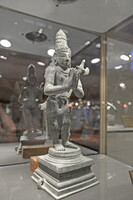Chandikesvara
| dc.coverage.spatial | Site: Government Museum and National Art Gallery (Chennai, Tamil Nādu, India) Acc.No. 1048/81 | en_US |
| dc.coverage.temporal | ca. 15th century (creation) | en_US |
| dc.creator | unknown (Indian (South Asian)) | en_US |
| dc.date | 1400-1499 | en_US |
| dc.date.accessioned | 2016-08-23T18:13:55Z | |
| dc.date.available | 2016-08-23T18:13:55Z | |
| dc.date.issued | 1400-1499 | en_US |
| dc.identifier | 268013 | en_US |
| dc.identifier.other | archrefid: 3360 | en_US |
| dc.identifier.uri | http://hdl.handle.net/1721.3/184327 | |
| dc.description | Overall view, standing, hands in the Anjali mudra, with an axe; In Hinduism, the Ganas are attendants of Shiva and live in Kailasa. Shiva's son Ganesha is "lord of the ganas", but Chandiskesvara is chief among them. The original name of Chandiskesvara was Visarasarman, a Brahmin by caste; he was elevated and renamed Chandesa, Lord of passion, by Shiva for acts of devotion. This figure holds an axe, which alludes to the tale where Visarasarman cut off his father's leg because of his father's sacrilege. Shiva restored the father's leg when he elevated Visarasarman. Statue from Jambavanodai, Undivided Thanjavur District. Source: Sridhar, T.S., editor; Exhibition on Chola Bronzes, Chennai: State Department of Archaeology, 2011 ([online at http://210.212.62.26/pdf_files/books/Chola%20Bronzes%20part%20001.pdf]) (accessed 5/6/2015) | en_US |
| dc.format.medium | bronze | en_US |
| dc.rights | © Scott Gilchrist, Archivision, Inc. | en_US |
| dc.subject | deities | en_US |
| dc.subject | Hinduism | en_US |
| dc.subject | Vijayanagar | en_US |
| dc.title | Chandikesvara | en_US |
| dc.type | image | en_US |
| dc.rights.access | Licensed for educational and research use by the MIT community only | en_US |
| dc.identifier.vendorcode | 7A2-IN-GMC-CHAND-A01 | en_US |
| vra.culturalContext | Indian (South Asian) | en_US |
| vra.technique | casting (process) | en_US |
| vra.worktype | sculpture (visual work) | en_US |
| dc.contributor.display | unknown (Indian) | en_US |
Files in this item
This item appears in the following Collection(s)
-
Architecture, Urban Planning, and Visual Arts
Online Image Collection


